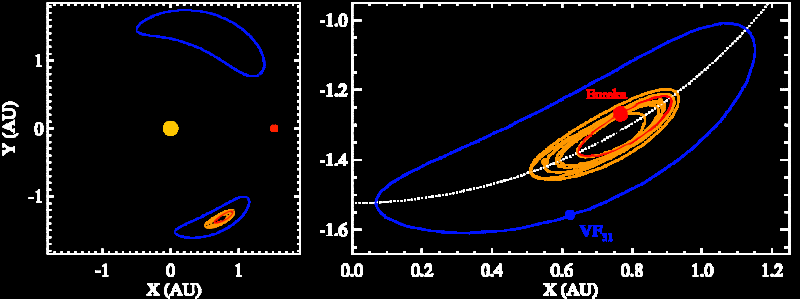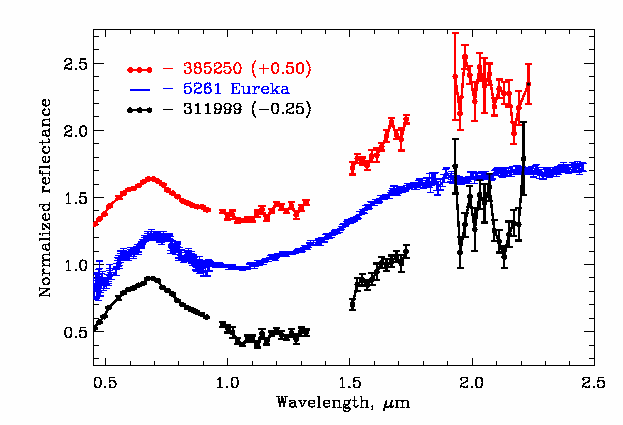Astronomers find orbit of Mars hosts remains of ancient mini-planets

The planet Mars shares its orbit with a handful of small asteroids, the so-called Trojans. Now an international team of astronomers using the Very Large Telescope in Chile have found that most of these objects share a common composition; they are likely the remains of a mini-planet that was destroyed by a collision long ago. The findings are reported in a paper to appear in Monthly Notices of the Royal Astronomical Society in April.
Trojan asteroids move in orbits with the same average distance from the Sun as a planet, trapped within gravitational "safe havens" 60 degrees in front of and behind the planet. The special significance of these locations was worked out by 18th century French Mathematician Joseph-Louis Lagrange. In his honour, they are now known as "Lagrange points"; the point leading the planet is L4; that trailing the planet is L5.
About 6000 such Trojans have been found at the orbit of Jupiter and about 10 at Neptune's. They are believed to date from the solar system's earliest times when the distribution of planets, asteroids and comets was very different than the one we observe today.
Mars is so far the only terrestrial planet known to have Trojan companions in stable orbits. The first Mars Trojan was discovered over 25 years ago at L5 and named "Eureka" in reference to the famous exclamation by Ancient Greek mathematician Archimedes. The present tally is nine, a factor of 600 fewer than Jupiter Trojans, but even this relatively puny sample shows interesting structure not seen elsewhere in the solar system.

For starters, all the Trojans, save one, are trailing Mars at its L5 Lagrange point (Figure 1, left panel). What's more, the orbits of all but one of the 8 L5 Trojans group up around Eureka itself (Figure 1, right panel). The cause for the uneven distribution of these objects has not yet been pinned down, though there are a couple of possibilities. In one scenario, a collision broke up a precursor asteroid at the L5 point, the fragments making up the group we observe today. Another possibility is that a process called rotational fission caused Eureka to spin up, eventually spawning off small pieces of itself in heliocentric orbit. Whatever the cause, the grouping strongly suggests that the asteroids in this "Eureka family" were once part of a single object or a progenitor body. Although the circumstantial evidence for this hypothesis is strong, the acid test is to find out whether the asteroids share a common composition or not. Fortunately, this can be done at the telescope by measuring the colour of sunlight reflected off the asteroid's surface, in other words obtaining its spectrum.
For this purpose, an international team of astronomers led by Apostolos Christou and Galin Borisov at the Armagh Observatory and Planetarium in Northern Ireland, UK, used the X-SHOOTER spectrograph mounted on "Kueyen", the Unit 2 telescope of the European Southern Observatory's Very Large Telescope facility in Chile in early 2016 to record the spectra of two asteroids that belong to the Eureka family, 311999 and 385250. Analysing the spectra, they found that both objects are "dead ringers" for Eureka (Figure 2), so confirming the genetic relationship between family asteroids. The finding also marks a significant "first" for asteroid studies; the spectra show that these asteroids are predominantly composed of olivine, a mineral that typically forms within much larger objects under conditions of high pressure and temperature. The implication is that these asteroids are likely relict mantle material from within mini-planets or "planetesimals" which, like the Earth, developed a crust, mantle and core through the process of differentiation but have long since been destroyed by collisions.
Christou points out that "Many other families exist in the Asteroid Belt between Mars and Jupiter, and even among Jupiter's Trojans, but none are made up of such olivine-dominated asteroids". This is related to the so-called missing-mantle problem: that is, if one adds up the mass of different minerals in the asteroid belt and particularly those thought to be pieces of broken up, differentiated asteroids, there is a deficit of mantle material compared to rocky crust and metallic core material.
Although the discovery of this olivine-dominated family does not provide a final solution to the missing mantle problem, it does show that mantle material was present near Mars early in the solar system's history. As Christou explains: "Our findings suggest that such material has participated in the formation of Mars and perhaps its planetary neighbour, our own Earth."
More information: G. Borisov et al. The olivine-dominated composition of the Eureka family of Mars Trojan asteroids, Monthly Notices of the Royal Astronomical Society (2017). DOI: 10.1093/mnras/stw3075
Journal information: Monthly Notices of the Royal Astronomical Society
Provided by Armagh Observatory





















